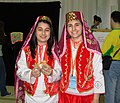Influences
Traditional folk clothing throughout Turkey today is heavily influenced by Ottoman fashion and based on the developments that occurred during and after the Empire’s reign. The borders of the Ottoman Empire encompassed the numerous individual cultures, people, religions and traditions that existed throughout Central Asia, Eastern Europe, Southern Europe, the Middle East, Central Europe, and Anatolia. Ottoman culture, and particularly Ottoman fashion evolved as an amalgam of these separate cultures and religions that had interacted over the past centuries of Ottoman reign.
“Ottoman culture” was used to define and generalize all present cultures and traditions within the empire, not the present or ruling Turkic culture specifically, though Turkic culture within the empire had ultimately embodied itself with other present Ottoman cultures and inherited many of its aspects, creating the basis of Turkish culture and diverse identity today. These set the stepping-stone for further developments of the Turkish culture that would continue on until the collapse and dissolution of Ottoman reign, and even after the establishment of the republic; Following several migration waves occurring into the country from Southern Europe (Albania and Greece), Eastern Europe (particularly Romania, Bulgaria and Yugoslavia), the Caucasus, and presently from the Middle East, Russia, and Ukraine.
History
Ottoman fashion had not disappeared following the collapse of the Ottoman Empire; as it remained as part of daily use and continued on to evolve within the several nations that emerged from the empire before and after the dissolution, including the newly established Republic of Turkey. Some notable features and dress of Ottoman fashion included the mintan, a heavily embroidered chainse or vest; a şalvar, embroidered baggy pants; the sarık, a large, wrapped headpiece usually differing from a traditional turban and region-to-region; and the entari, a long flowy embroidered dress worn typically by women in the empire.
Although the notable Fez was also used by non-Muslim communities within the empire without religious intend, it was one of the earliest to fall out of fashion in these regions following the collapse with the sarık, including Turkey, after the official ban of the headwear in 1925. Though the sarık remained in-use by Muslim communities in former Ottoman lands and the rural areas of Turkey. [2]
Modern Turkish folk dress throughout Turkey today lacks most of the religious aspects of these dress due to governmental pressure and restrictions applied throughout the 20s and late 30s, though has inherited a significant portion of other features with small modifications to a lesser extent. Similar features of modern Turkish folk dress throughout Turkey include: the mintan, şalvar, entari, gömlek/bluz (blouse), çarık, kuşak (similar to a girdle, cloth waist-wrap, or cincture), mendil (similar to a neckerchief) and yelek (a vest).




